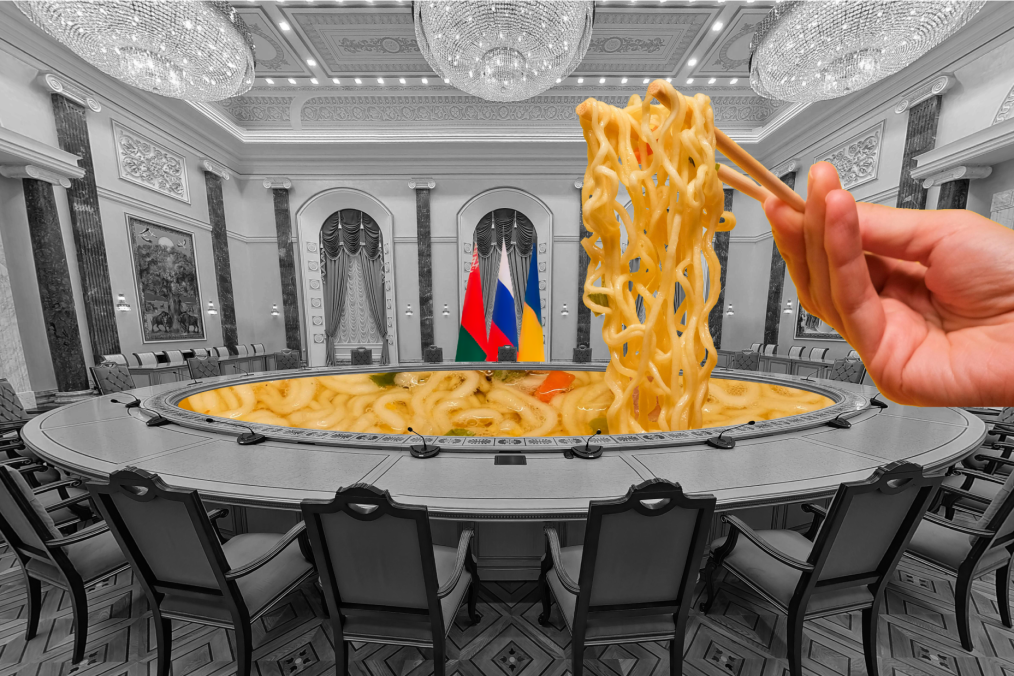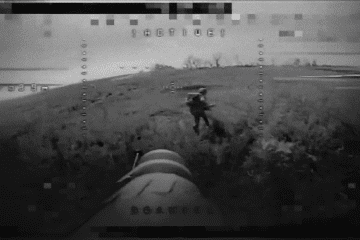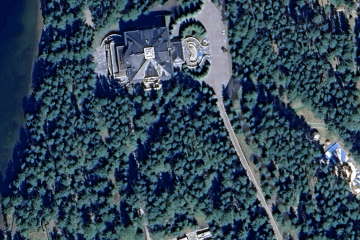- Category
- War in Ukraine
The Minsk Agreements and Moscow’s False Ceasefire Promises Behind Russia’s Full-Scale Invasion of Ukraine

The Minsk agreements were meant to silence the guns in Ukraine’s east. Yet Moscow shattered its promise of peace the moment the ink dried—paving the way for Russia’s full-scale invasion.
Russia occupied Ukraine’s Crimea in the winter of 2014, and by spring, Russian troops and funds poured into Ukraine's east. April 12th, 2014, is considered one of the starting points in the war between Ukraine and Russia in modern history.
On that day, several dozens of heavily armed forces seized the city of Sloviansk in the Donetsk region, led by Igor Strelkov (Girkin), a retired colonel of the FSB (Russia’s Federal Security Service). The Minsk agreements were supposed to end this chaos and war, but instead, the situation only worsened, eventually escalating into full-scale war.
What is the Minsk Agreement?
The Minsk Agreement, signed in Belarus’s capital, Minsk, aimed to establish a temporary ceasefire between Russia and Ukraine amid the 2014 war driven by Russia’s hybrid warfare in Ukraine’s Donetsk and Luhansk regions.
Since the provisions of the first protocol were not followed, a second agreement, known as Minsk II, was signed a year later, in 2015.
Today, the term "Minsk peace agreements" refers to three joint documents from the parties involved in resolving the war between Russia and Ukraine in the Donetsk and Luhansk regions.
Talks aimed at resolving the situation in Donetsk and Luhansk, along with broader discussions on Russian aggression against Ukraine, were held in the “Normandy format,” involving Ukraine, Germany, France, and Russia.
There is often a misconception about NATO's involvement in the Minsk agreements, but in reality, the alliance had no involvement in their creation or signing.
Who signed the Minsk agreements?
The documents were signed by the authorized participants of the Trilateral Contact Group on the peaceful resolution of the situation in eastern Ukraine. This group was formed as a means to facilitate a diplomatic resolution to the war in eastern Ukraine and consists of representatives from Ukraine, the Organization for Security and Cooperation (OSCE), and Russia. The agreements were signed by Ukraine’s former President Leonid Kuchma, then-Russian Ambassador to Ukraine Mikhail Zurabov, and OSCE Special Representative Heidi Tagliavini.
Minsk I (September 5, 2014)
The full title of the first Minsk Agreement is the "Protocol on the Results of Consultations of the Trilateral Contact Group on Joint Steps Aimed at the Implementation of the Peace Plan of the President of Ukraine Petro Poroshenko and the Initiatives of the President of Russia Vladimir Putin."
However, as mentioned above, this protocol was signed not by then-President of Ukraine Petro Poroshenko and Russian President Vladimir Putin, but by representatives of the Trilateral Contact Group.
In addition, the signatures of the then-leaders of the illegal groups of the Donetsk and Luhansk People's Republics (DNR and LNR)—Alexander Zakharchenko and Igor Plotnitsky—also appear on Minsk I. However, their signatures are presented as private individuals' autographs and have no legal significance.
The first Minsk Agreement was signed following the direct intervention of regular Russian troops in the war in Donetsk and Luhansk, after fierce battles for Ilovaisk and the heavy shelling of a Ukrainian military column, despite promises of a “humanitarian green corridor.”
The ceasefire was announced simultaneously with the warning of the introduction of another round of sanctions by the coalition of world powers against Russia if it did not stop its aggression, as well as the suspension of NATO partnership with Russia.
On the same day, September 4, 2014, President Poroshenko participated in the NATO Summit in Wales, where he received support from NATO member countries and the agreement of some countries to supply Ukraine with modern weapons.
The following day, a temporary ceasefire agreement was reached in Minsk and took effect on September 5.
The official text of the Minsk Agreement is a protocol that includes the following obligations:
1. Ensure the immediate bilateral cessation of the use of weapons.
2. Implement decentralization of power, including through the adoption of the Law of Ukraine "On the Temporary Order of Local Self-Government in Certain Areas of the Donetsk and Luhansk Regions" (Special Status Law).
3. Immediately release all hostages and unlawfully detained persons.
4. Take measures to improve the humanitarian situation in Donbas.
5. Ensure the holding of early local elections in accordance with the Law of Ukraine "On the Temporary Order of Local Self-Government in Certain Areas of the Donetsk and Luhansk Regions" (Special Status Law).
6. Withdraw illegal armed formations, military equipment, as well as militants and mercenaries from the territory of Ukraine.
Thus, the text of the Minsk Agreement does not provide for any recognition of the Donetsk and Luhansk "people's republics," but only grants the territories controlled by pro-Russian militants in the two regions "special status" within Ukraine.
Two weeks after the signing of the Protocol, the work of the contact group continued. On September 19, the parties signed a Memorandum on the Implementation of the Provisions of the Protocol (Minsk I). The Memorandum included agreements on:
bilateral ceasefire;
withdrawal of heavy weaponry 15 km away from the then-line of contact;
prohibition of combat aviation and drone flights;
prohibition of laying mine-explosive barriers in the established security zones;
deployment of an OSCE monitoring mission in the ceasefire zone, consisting of the organization's observer group and representatives from the Ukrainian and Russian sides;
continuation of the exchange of prisoners of war.
The status of the territories seized by the militants was not discussed during the Minsk negotiations.
Minsk I Agreement violations
Despite the ceasefire, Ukraine’s National Security and Defense Council (NSDC) reported continued clashes in Donetsk and Luhansk, along with Russian armored movements, shelling in Mariupol, and an attempted assault on Donetsk Airport.
By late November 2014, ceasefire violations by Russian forces and militants had reached approximately 3,500 incidents since the signing of the Minsk agreements, according to official data from Ukraine’s Ministry of Foreign Affairs.
A total of 957 people were killed in Ukraine’s east from the start of the ceasefire on September 6 until November 18, according to the Office of the United Nations High Commissioner for Human Rights.
Shelling of Ukrainian territory from the Russian side resumed on November 20, 2014, according to Ukraine’s State Border Guard Service.
Later, there were violations of Ukraine's airspace by Russian aircraft, as well as shelling with heavy weaponry, including attacks on civilian targets, which resulted in casualties.
Contrary to the Minsk agreements and the procedures established by the Constitution and laws of Ukraine, on November 2, 2014, representatives of terrorist organizations held illegal elections for the heads and people's councils of the so-called DNR and LNR in certain areas of Donetsk and Luhansk regions. As a result of these "elections," Alexander Zakharchenko and Igor Plotnitsky became the "leaders" of the DNR and LNR.
Ukraine's Security Service and Ministry of Internal Affairs classified this imitation of "elections" as a large-scale crime and documented widespread cases of intimidation, blackmail, and bribery of local residents.
The election process was monitored by representatives of a fictitious organization, the "Association for Security and Cooperation in Europe," as well as observers from other unrecognized states — South Ossetia and the Nagorno-Karabakh Republic, who were invited by the DNR leadership.
In response, the EU's High Representative for Foreign Affairs and Security Policy, Federica Mogherini, stated that the "vote became a new obstacle on the path to peace," and that the election results were "illegal and illegitimate."
“The Russian Federation’s Security Council decided on January 23 to intensify offensive operations on nearly all fronts in eastern Ukraine,” announced NSDC Secretary Oleksandr Turchynov on January 24, 2015.
Another round of negotiations took place in Minsk by January 31, 2015, after which Leonid Kuchma reported that the representatives of the so-called DNR and LNR again insisted on redefining the contact line, but did not participate in the contact group meeting despite being invited.
The final collapse of the Minsk agreements occurred against the backdrop of a large-scale offensive by Russian militants on Debaltseve, with fighting continuing from January 21 to February 18, 2015.
Minsk II (February 11-12, 2015)
The second Minsk Agreement was reached at a summit in Minsk on February 11-12 by the leaders of Germany, France, Ukraine, and Russia and signed by the same contact group.
As a result of a 17-hour meeting, a “Declaration supporting the Package of Measures for the Implementation of the Minsk Agreements” was signed, and steps for implementing the agreements were outlined. The document consists of 13 points, including:
1. Immediate and comprehensive ceasefire in certain areas of Donetsk and Luhansk regions of Ukraine and its strict implementation starting from 00:00 on February 15.
2. Withdrawal of heavy weaponry by both sides at equal distances to create a security zone.
3. OSCE monitoring and verification.
4. Ensure safe access, delivery, storage, and distribution of humanitarian assistance to those in need based on an international mechanism.
5. Restoration of full control over the state border by the Ukrainian government throughout the conflict zone.
6. Adoption of permanent legislation on the special status of certain areas of Donetsk and Luhansk regions.
7. Based on the Law of Ukraine "On the Temporary Order of Local Self-Government in Certain Areas of Donetsk and Luhansk Regions," issues related to local elections will be discussed and agreed upon with representatives of these areas within the framework of the Trilateral Contact Group. The elections will be conducted in accordance with OSCE standards and monitored by the organization.
The record-length negotiations over this agreement were due to Putin’s deliberate stalling to give more time for militant units to encircle Ukrainian troops, noted then-President of France Franсois Hollande.
In his 2018 book “Lessons of Power”, Hollande said that Putin's true goal was to weaken the Ukrainian government to eventually install a more Russia-friendly team that would be less inclined toward rapprochement with Europe and joining NATO.
"Vladimir Putin wants to restore the sphere of influence that the Soviet empire once had,” writes Hollande. “Putin desires a buffer zone of obedient states around his country. His tactic is to stir up conflicts between his friends and his opponents, then freeze them.”
Minsk II Agreement violations
But again, almost immediately after the ceasefire was announced, the OSCE monitoring mission recorded shelling of Ukrainian army positions by Russian armed groups using artillery, mortars, and multiple rocket launchers. When the OSCE tried to send its observers to Debaltseve, representatives of the DNR refused.
It is known that during the first day of the "silence," Russian terrorists launched 112 strikes on Ukrainian military positions.
Later, the "DNR leader" Alexander Zakharchenko threatened to "recapture" Mariupol and seize Kharkiv. Meanwhile, the Russians and the illegal groups of the quasi-republics continued to strike Ukrainian forces and civilian targets. The Russians reportedly began firing on Debaltseve more intensely than before the "ceasefire." In response, the European Union imposed a new list of sanctions against Russia.
German Foreign Minister Frank-Walter Steinmeier proposed the "Steinmeier formula" at the Normandy Four summit in Paris on October 15. This formula outlined the procedure for holding elections in the DNR and LNR, after which their legitimacy would be confirmed by a special OSCE mission, following recognition by Ukraine's Central Election Commission.
However, OSCE standards require state control over areas where elections are held, meaning Ukraine would need control over the "special areas of Donetsk and Luhansk regions" and its border. But the Kremlin consistently insisted that elections in these areas should take place before Russia handed over control of the border.
There’s a “nuance” in the Minsk II agreement: Point 9 calls for Ukraine to regain full control of the state border throughout the conflict zone on the first day after local elections. At the same time, Point 12 states that these elections must follow OSCE standards.
"This means that one principle of this Minsk document contradicts another. Thus, these are agreements that are essentially impossible to implement," said Serhiy Harmash, a member of the Ukrainian delegation to the Trilateral Contact Group for the peaceful settlement of the situation in Donetsk and Luhansk regions.
In other respects, of all the obligations established by the second Minsk agreement, only a few have been fulfilled:
continuous monitoring of the situation in the conflict region by OSCE observers;
improvement of the humanitarian situation in the conflict region.
The final rupture of the second Minsk Agreement occurred on February 21, 2022, when Russia recognized the independence of the so-called DNR and LNR.
Why doesn't Ukraine want "Minsk III"?
Putin's main goal is not to establish peace in Ukraine but to force its capitulation and strip it of its independence.
This is precisely why the provisions of previous "peace agreements," as well as those proposed now, contain clauses that are either impossible to implement or are interpreted differently by the parties involved.
"If Russia says it wants to end this war, let it prove it with actions. It is obvious that Russia's words cannot be trusted. There will be no 'Minsk-3' that Russia will violate immediately after signing. We will not allow Russia to wait, regroup, and start a new wave of terror and global destabilization," emphasized Ukrainian President Volodymyr Zelenskyy in his speech at the G-20 summit, noting that future peace must be just and based on the UN Charter, not hastily or haphazardly or with concessions of sovereignty or territories.


-f88628fa403b11af0b72ec7b062ce954.jpeg)
-b63fc610dd4af1b737643522d6baf184.jpg)


-29a1a43aba23f9bb779a1ac8b98d2121.jpeg)

-24deccd511006ba79cfc4d798c6c2ef5.jpeg)